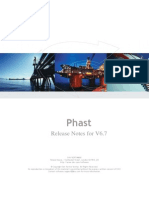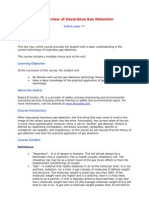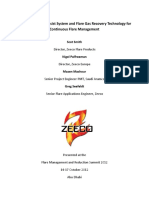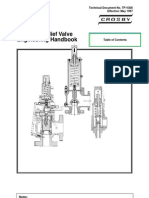Dynamic Simulation of Compressor Systems
Uploaded by
DoctorObermanDynamic Simulation of Compressor Systems
Uploaded by
DoctorObermanInvensys
White Paper
is now
High Fidelity Dynamic Simulation of Compressor Systems
Realize the benefits of 20/20 hindsight before commissioning
a new compressor or new compressor controls
Authors: Jim Jacoby: Director, Turbomachinery Controls Portfolio, Triconex
Ian Willetts PhD: Global Consulting Director, SimSci-Esscor
Alan Wade, Department of Engineering Science, University of Oxford
Whats Inside:
1. Introduction
2. Dynamic Simulation An Enabling Technology
3. Benefits
4. Cost Savings Ensuring Equipment Sizing and Selection
5. Time Savings Reduced Commissioning Time from
Pre-Tuning
6. Safety Improved Operator Training
7. Availability Verifying Startup/Shutdown Procedures
8. Summary
9. References
High Fidelity Dynamic Simulation of Compressor Systems
Realize the benefits of 20-20 hindsight before commissioning
a new compressor or new compressor controls
1. Introduction
In recent times, the integration of turbomachinery control functions and hardware into a single high reliability platform with
robust control algorithms, such as the industry-leading Triconex Tricon platform, has led to significant improvements in system
performance and operability. In the past, a compressor train might have had separate controllers for suction pressure, recycle and
turbine or motor speed as well as separate relay sequencing and alarm panels, a separate vibration-monitoring package and a
separate over speed trip protection package. Now, to meet the requirements of todays industry standards, only the over speed
protection system is required.
While improvements are continually made to turbomachinery control system hardware and software, it is important to ensure that the
process side design that includes the compressor specification, anti-surge and throttle valves sizes and ancillary equipment is sufficient
to allow the industry leading control programs to provide the required protection. No matter how superior the control platform, an
incorrectly specified anti-surge valve and recycle loop can cost millions of dollars in lost production if discovered during the Site
Acceptance Test.
Once the design is verified, focus can turn to the ensuring the control system is configured correctly and tuned prior to the
commissioning process. For example, an overly conservative anti-surge control can lead to unnecessarily high recycle rates affecting
operating efficiency, while protecting the critical equipment. On the other hand, a poorly configured anti-surge controller can fail to
prevent compressor surge, leading to irreparable damage to the equipment and risk to personnel safety.
Therefore, the success of a project is often determined before the Site Acceptance Test begins, when an engineer has the tools to
verify the system design and to test the control logic across the full operating range of the compressor system being commissioned.
2. Dynamic Simulation - An Enabling Technology
Dynamic simulation models were first used in the turbomachinery business more than 25 years ago to validate the sizing of the recycle
valves on large LNG compressor trains. These studies required detailed data about the entire piping system and taking months to
complete. Womack (1986) discussed this and other applications of dynamic simulation and noted at the time that although dynamic
simulation was an expensive, and slow-to use tool, the ability to reduce the Opinion Engineering content of plant design, and to
provide twenty-twenty hindsight before start-up justified the required time and cost.
Today, computers support more sophisticated object-based
simulation software (such as SimSci-Esscors DYNSIM platform)
that allow far more detailed compressor models to be created
in weeks rather than months. Furthermore, the DYNSIM
software can be integrated and run directly with an emulation
of the actual Triconex Tricon turbomachinery control (TMC)
configuration program on a single computer. This integrated
control and process-modeling platform allows rigorous system
testing under all operating conditions in a safe environment,
where faults can be discovered without creating enormous costs
or posing a risk to human safety.
Four distinct areas of benefit can be realized using high
fidelity TMC Integrated Dynamic Simulation models to check
out the process design and control configuration around
turbomachinery applications. These benefits can be realized at
various stages of the process life cycle and can be applied to
almost any project underway today.
DIAGRAM 1: Triconex TMC Integrated Dynamic Simulation Platform
Page 1
High Fidelity Dynamic Simulation of Compressor Systems
Realize the benefits of 20-20 hindsight before commissioning
a new compressor or new compressor controls
3. Benefits
Four distinct areas of benefit can be realized using hi-fidelity TMC Integrated Dynamic Simulation models to review the process design
and control configuration around turbomachinery applications. These benefits can be realized at various stages of the process life
cycle and can be applied to most projects underway today, and include:
COST SAVINGS
Front End Engineering Design (FEED): Avoid costly design errors by verifying, for example, that valve and vessel sizes and
equipment configurations are correct early on when changes can be made at minimum cost. This integrated solution allows the
engineering company to verify that the overall system will perform as designed.
Design: The sizing and selection of the compressor can be tested against the actual process requirements, ensure optimum recycle
flow rate under normal operating conditions, reduce power consumption and improve efficiency.
Pre-Factory Acceptance Test (FAT): Running the actual control code integrated with a dynamic simulation model makes control
programs easier to debug and improve.
TIME SAVINGS
Factory Acceptance Test (FAT): The TMC Integrated Dynamic Simulation model allows for detailed testing of the actual control
program logics and sequencing. A relatively clean and tested control code at FAT saves critical time during the FAT.
Site Acceptance Test (SAT): Changes to the control program can be tested against the model and corrections made prior to going
live on a system, saving commissioning time.
SAFETY
Operator Training: The TMC Integrated Dynamic Simulation model can be used to conduct operator training before and after start-up.
Safer Operation: Compressor surge can result in costly equipment damage and potential relief scenarios can be dramatically
reduced by initially implementing a tested, well designed and tuned controller.
AVAILABILITY
Commissioning and Start-up: Since the control program has been evaluated against a dynamic simulation of the local process,
start-up proceeds in a straightforward and timely manner, bringing the process online quicker.
Cost Savings: The simulation can pay for itself on the initial start-up. Furthermore, the simulation can be used as a training tool for
operators and engineers and enable operational improvements on an on-going basis, including future control upgrades.
The following section discusses four project types recently executed by Invensys Operations Management and using TMC Integrated
Dynamic Simulation models, various benefits were realized in a cost effective and safe manner.
4. Cost Savings - Ensuring Equipment Sizing and Selection
Typically, drums, piping and valves associated with a compressor system are sized based on flows calculated by steady-state heat &
mass balances and engineering judgment (such as full recycle for the sizing of anti-surge piping). By definition, surge is a transient
event. As dynamic simulation calculates time-variation in all variables of interest from first-principles equations, it can determine if the
layout and equipment size are adequate to cope with the transient conditions.
The following is an example where a TMC Integrated Dynamic Simulation was used in the design phase that lead to identifying issues
in the original system design. The system involved a 4-stage compressor system, where all the stages were driven at the same speed
by a single electric motor. The original design included a cold gas recycle stream between the fourth stage discharge and the suction
drum upstream of the first stage. While initiating a test case where the electric motor was tripped, it was discovered that the original
designed cold recycle was insufficient to stop the first and second stages from surging. This happened for all anti-surge valve sizes
that were installed, even when the valve was fully opened before the trip. The issue was likely due to the loss of the motor, causing a
sudden drop in pressure across the fourth stage, quickly moving towards a stall (see Figure 1).
Page 2
High Fidelity Dynamic Simulation of Compressor Systems
Realize the benefits of 20-20 hindsight before commissioning
a new compressor or new compressor controls
Figure 1: Operating Point of Stage 4 Compressor during Machine Trip
The fourth stage pressure, after the trip, was insufficient to supply the necessary flow-through the anti-surge valve, preventing the first
and second stages from surging. Figure 2 shows each compressor stage surge margin versus time. Surge margin is a measure of the
approach of the compressor operating point toward the surge line. A negative surge margin indicates the compressor is surging.
Figure 2: Surge Margins of Compressor stages without Hot Gas Bypass
Alternative solutions to mitigate this issue were tested on the simulation model and the best solution was to add a hot gas bypass
around the first two stages of compression. With proper sizing of the valve in this line and the addition of the required logic in the
control program, the controls kept all four-compressor stages out of surge after the motor trip (see Figure 3). The issue was identified
and corrected at a minimal cost early on during the project using the TMC Integrated Dynamic Simulation model.
Page 3
High Fidelity Dynamic Simulation of Compressor Systems
Realize the benefits of 20-20 hindsight before commissioning
a new compressor or new compressor controls
Figure 3: Surge Margins of Compressor stages with Hot Gas Bypass
5. Time Savings Reduced Commissioning Time from Pre-Tuning
TMC Integrated Dynamic Simulation models can be used to optimize the tuning of the PID controllers within the turbomachinery
controls. Traditionally, tuning is performed in the plant, post-startup of the turbomachinery. However, these tests run the risk that if the
controller is originally ill-conditioned; the step changes could cause an undesirable response, placing the compressor into surge.
Alternatively, these tests can be run in a dynamic simulation, where fault discovery does not have serious repercussions. Tuning is
completed on the dynamic simulation model by reviewing the response to step changes in the operating point of the plant, and
modifying the parameters of the controller (such as varying the overshoot or rise time) and the desired response. Once the actual plant
is initiated, only fine-tuning of the controller is required. This mitigates the risk of undesirable behavior and reduces the time between
start-up and commencement of production, allowing the new compressor system to generate revenue sooner.
Triconex TMC Integrated DYNSIM Simulation model was successfully implemented on a steam turbine driven Ethane Recycle
compressor. The project goal was to verify the Triconex control logic and tuning prior to commissioning, which included determining
the best control strategy and assessing the value of De-coupling Control between the kickback valve and the Inlet Guide Vanes (IGV).
Start-up sequence assessment included determining the optimum IGV loading and understanding the flow transition time from flowthrough the bypass check valve to flow-through the compressor.
Page 4
High Fidelity Dynamic Simulation of Compressor Systems
Realize the benefits of 20-20 hindsight before commissioning
a new compressor or new compressor controls
Figure 4: Ethane Recycle Compressor Process Model
Once the optimum control strategy was developed, the model was used to test the surge control responses, the speed control and
make appropriate tuning changes.
Upon project completion, the customer reported that the compressor start-up was one of the smoothest ever experienced with the
commissioning occurring three days faster than originally scheduled.
6. Safety Improved Operator Training
TMC Integrated Dynamic Simulation models have many benefits when used as a tool to train operators on the turbomachinery
operation and controls. These models implement the actual control code to be used in the plant and the models; operators can be
trained within the simulator where their actions have the same impact as in a real plant. Using the simulation, operator mistakes do
not risk safety or cost, and the model can be easily reset to the starting conditions from any state. These features make the TMC
Integrated Dynamic Simulation models a valuable tool when training operators to use a new piece of equipment, provide new
operators with experience that could previously only be learned with years on the job, or coach out bad habits. Models can be
programmed with malfunction scenarios (such as a valve failure within the actual plant), where the response of the operators could be
crucial for keeping the system in safe operation. Additionally, the model can be setup to use the same HMI (Human Machine Interface)
as the controls system in the plant, to complete the feel of the simulator, and skills learned within the simulator are easily transferred to
the actual plant.
Figure 4 shows a TMC Integrated Dynamic Simulation model that was set up for a new 4-stage compressor as part of a case study with
the actual HMI. Using the TMC Integrated Dynamic Simulation model to train operators on new equipment before installation and in
combination with the pre-tuning of the compressor controls, the client was able to smoothly start-up and have the compressor system
running at maximum efficiency in less than half of the scheduled time for this type of normal installation. These unanticipated extra
days of production led to millions of dollars in additional revenue for the operating company.
Page 5
High Fidelity Dynamic Simulation of Compressor Systems
Realize the benefits of 20-20 hindsight before commissioning
a new compressor or new compressor controls
Figure 5 - HMI view of Operator Training Simulator
7. Availability Verifying Startup/Shutdown Procedures
TMC Integrated Dynamic Simulation models can implement the exact control code to be used in a plant, and be used to verify that
the control system can adequately handle start-ups and planned shutdowns of the system prior to the initial start-up of the plant
during the SAT. Scenarios can be programmed to step through the startup and shutdown sequencing. Procedure can be validate
and help avoid any surprises upon initial start-up and improve the reliability and availability of the turbo-machines by shortening
commissioning time and preventing equipment damage.
In this example, the air blower system for a Fluid Catalyst Cracking Unit (FCCU) was particularly sensitive to the startup and shutdown
sequencing. The system consisted of four compressors arranged in three circuits as shown in Figure 5, along with corresponding
recycle valves and snort valves that discharged to the atmosphere and kept the units from surging.
Page 6
High Fidelity Dynamic Simulation of Compressor Systems
Realize the benefits of 20-20 hindsight before commissioning
a new compressor or new compressor controls
Figure 6: Schematic of compressor layout
Units 1-3 were centrifugal compressors driven by an electric motor and unit 4 was an axial compressor driven by a steam turbine. Because
the downstream units had to be operating before there was sufficient steam supply to run the fourth compressor, it had to be started
last. The previous start-up method had been to start the units up in numerical order, taking each of them up to their maximum capacity in
order to provide the maximum margin from surge possible and control the required flow by venting the snort valves to the atmosphere.
This approach was extremely inefficient with the operators erring on the side of safety over efficiency without any available system.
Part of the dynamic simulation performed on this setup was to verify the start-up sequence of the compressors operating with
decoupling controls to balance the capacity controller and anti-surge controller. Triconex proprietary decoupling algorithms help
ensure maximum efficiency with safe surge margins. Figure 6 shows the flows of all four compressors during startup. A master flow
controller with load sharing was designed and added to the control configuration to control the target flow required by the process.
The flow is steadily built-up to the target flow, while keeping all compressors out of surge. The study also identified the minimum
position required on the suction valves of the compressors in order to keep the motors from tripping due to high current spikes.
Figure 7: Compressor Flows during the Startup Sequence
Page 7
High Fidelity Dynamic Simulation of Compressor Systems
Realize the benefits of 20-20 hindsight before commissioning
a new compressor or new compressor controls
8. Summary
The four proceeding case studies clearly show dramatic benefits that can be realized using SimSci-Esscors Turbomachinery Controls
Integrated Dynamic Simulation solution and services. These benefits can be realized throughout the life cycle process for companies
doing preliminary design work or upgrading turbomachinery controls on existing equipment.
Today, where industry demand is to provide more value-relative to the money spent, this solution stands out as one of the most
exciting and new offerings available today, providing a wide variety of tangible and intangible benefits with very high rates of return.
9. References
J.W.Womack, Dynamic simulation in the processing industries: case studies from Mobil experience, Modeling, Identification &
Control, Vol. 6 Issue 4, 1986, pp.201-216.
Invensys Operations Management 5601 Granite Parkway III, #1000, Plano, TX 75024 Tel: (469) 365-6400 Fax: (469) 365-6401 iom.invensys.com
Invensys, the Invensys logo, ArchestrA, Avantis, Eurotherm, Foxboro, IMServ, InFusion, SimSci-Esscor, Skelta, Triconex, and Wonderware are trademarks of Invensys plc, its subsidiaries or affiliates.
All other brands and product names may be the trademarks or service marks of their representative owners.
2010 Invensys Systems, Inc. All rights reserved. No part of the material protected by this copyright may be reproduced or utilized in any form or by any means, electronic or mechanical, including
photocopying, recording, broadcasting, or by any information storage and retrieval system, without permission in writing from Invensys Systems, Inc.
Rev. 01/15
PN SE-0138
Page 8
You might also like
- High Fidelity Dynamic Simulation of Compressor SystemsNo ratings yetHigh Fidelity Dynamic Simulation of Compressor Systems9 pages
- Qatar Petroleum Ngl-1 Operating Manual: Vol: 1 Sec.: 6 1No ratings yetQatar Petroleum Ngl-1 Operating Manual: Vol: 1 Sec.: 6 129 pages
- Onshore and Offshore: Echnical PresentationNo ratings yetOnshore and Offshore: Echnical Presentation66 pages
- 170630-1201 MultiPoint-Flare-SS FINAL JZHCNo ratings yet170630-1201 MultiPoint-Flare-SS FINAL JZHC4 pages
- Alarm Management System With Sofrel S 510 Operation ManualNo ratings yetAlarm Management System With Sofrel S 510 Operation Manual23 pages
- How To Calculate Flare Radiation Isopleths - Industrial Professionals - Cheresources0% (1)How To Calculate Flare Radiation Isopleths - Industrial Professionals - Cheresources5 pages
- Major Ammonia Leak From HP Ammonia Feed Pump1No ratings yetMajor Ammonia Leak From HP Ammonia Feed Pump12 pages
- Floating Production Storage and Offloading Units and Topside Facilities100% (1)Floating Production Storage and Offloading Units and Topside Facilities19 pages
- 69-Chiara Gilardi Foster Wheeler Italiana-Relief-E100% (1)69-Chiara Gilardi Foster Wheeler Italiana-Relief-E16 pages
- Process Plant and Skid Packages: Delham Engineering CompanyNo ratings yetProcess Plant and Skid Packages: Delham Engineering Company6 pages
- NewItem 91 NewItem 91 Sulphuric Acid Plants CoindsNo ratings yetNewItem 91 NewItem 91 Sulphuric Acid Plants Coinds51 pages
- 20190130-TEC-WST-LNG19 LM6000 Techinical PaperNo ratings yet20190130-TEC-WST-LNG19 LM6000 Techinical Paper12 pages
- CH-17 Boiler Protections and InterlocksNo ratings yetCH-17 Boiler Protections and Interlocks22 pages
- Distillation Dynamics and Control Workbook 2006 PDFNo ratings yetDistillation Dynamics and Control Workbook 2006 PDF18 pages
- Safety and Reliability Ammonia Plant ESD SystemNo ratings yetSafety and Reliability Ammonia Plant ESD System13 pages
- Ge - Determination of Hazardous Area Get-8591No ratings yetGe - Determination of Hazardous Area Get-85918 pages
- Cold Weather Startup & Winter Opn Best PracticeNo ratings yetCold Weather Startup & Winter Opn Best Practice4 pages
- QP Fire and Safety Philosophy - QP-PHL-S-0001 Rev.03 2013 31-45No ratings yetQP Fire and Safety Philosophy - QP-PHL-S-0001 Rev.03 2013 31-4515 pages
- Guidelines On Quantitative Risk Assessments (Qra) PDFNo ratings yetGuidelines On Quantitative Risk Assessments (Qra) PDF12 pages
- BakerHughes BN ReciprocatingCompressorsMonitoring Brochure-Web-NA-1112...No ratings yetBakerHughes BN ReciprocatingCompressorsMonitoring Brochure-Web-NA-1112...9 pages
- An Overview of Hazardous Gas Detection: Course OutlineNo ratings yetAn Overview of Hazardous Gas Detection: Course Outline9 pages
- Petronas Technical Standards: Offshore Temporary Refuges100% (1)Petronas Technical Standards: Offshore Temporary Refuges33 pages
- Greenhouse Gas Detection Based On Infrared Nanophotonic DevicesNo ratings yetGreenhouse Gas Detection Based On Infrared Nanophotonic Devices13 pages
- An Easy Method To Design Gas Vapor Relief System With Rupture DiskNo ratings yetAn Easy Method To Design Gas Vapor Relief System With Rupture Disk8 pages
- M004 & E004 Basic Safety in Process DesignNo ratings yetM004 & E004 Basic Safety in Process Design66 pages
- Production Availability and Reliability: Use in the Oil and Gas industryFrom EverandProduction Availability and Reliability: Use in the Oil and Gas industryNo ratings yet
- Brochure SimSci SIM4MEServicesForDynamicSimulation 08-10No ratings yetBrochure SimSci SIM4MEServicesForDynamicSimulation 08-1012 pages
- Knowledge in Control: Is It Possible To Control Critical Machinery With Technology Alone?No ratings yetKnowledge in Control: Is It Possible To Control Critical Machinery With Technology Alone?3 pages
- John Crane Gas Seals: Gas Seals and Their Application For Maximum ReliabilityNo ratings yetJohn Crane Gas Seals: Gas Seals and Their Application For Maximum Reliability41 pages
- Pressure Relief Valve Engineering Handbook92% (12)Pressure Relief Valve Engineering Handbook93 pages
- Improve 20selection 20and 20sizing 20of 20storage 20tanksNo ratings yetImprove 20selection 20and 20sizing 20of 20storage 20tanks6 pages
- Compressor Performance Map Generation and Testing Per SAE J1723No ratings yetCompressor Performance Map Generation and Testing Per SAE J172340 pages
- Essay No. 1: (Composed Under A 45-Minute Time Limit) Score (On The 0-6 Scale) : 6No ratings yetEssay No. 1: (Composed Under A 45-Minute Time Limit) Score (On The 0-6 Scale) : 67 pages
- High Fidelity Dynamic Simulation of Compressor SystemsHigh Fidelity Dynamic Simulation of Compressor Systems
- Qatar Petroleum Ngl-1 Operating Manual: Vol: 1 Sec.: 6 1Qatar Petroleum Ngl-1 Operating Manual: Vol: 1 Sec.: 6 1
- Alarm Management System With Sofrel S 510 Operation ManualAlarm Management System With Sofrel S 510 Operation Manual
- How To Calculate Flare Radiation Isopleths - Industrial Professionals - CheresourcesHow To Calculate Flare Radiation Isopleths - Industrial Professionals - Cheresources
- Floating Production Storage and Offloading Units and Topside FacilitiesFloating Production Storage and Offloading Units and Topside Facilities
- 69-Chiara Gilardi Foster Wheeler Italiana-Relief-E69-Chiara Gilardi Foster Wheeler Italiana-Relief-E
- Process Plant and Skid Packages: Delham Engineering CompanyProcess Plant and Skid Packages: Delham Engineering Company
- NewItem 91 NewItem 91 Sulphuric Acid Plants CoindsNewItem 91 NewItem 91 Sulphuric Acid Plants Coinds
- Distillation Dynamics and Control Workbook 2006 PDFDistillation Dynamics and Control Workbook 2006 PDF
- QP Fire and Safety Philosophy - QP-PHL-S-0001 Rev.03 2013 31-45QP Fire and Safety Philosophy - QP-PHL-S-0001 Rev.03 2013 31-45
- Guidelines On Quantitative Risk Assessments (Qra) PDFGuidelines On Quantitative Risk Assessments (Qra) PDF
- BakerHughes BN ReciprocatingCompressorsMonitoring Brochure-Web-NA-1112...BakerHughes BN ReciprocatingCompressorsMonitoring Brochure-Web-NA-1112...
- An Overview of Hazardous Gas Detection: Course OutlineAn Overview of Hazardous Gas Detection: Course Outline
- Petronas Technical Standards: Offshore Temporary RefugesPetronas Technical Standards: Offshore Temporary Refuges
- Greenhouse Gas Detection Based On Infrared Nanophotonic DevicesGreenhouse Gas Detection Based On Infrared Nanophotonic Devices
- An Easy Method To Design Gas Vapor Relief System With Rupture DiskAn Easy Method To Design Gas Vapor Relief System With Rupture Disk
- Production Availability and Reliability: Use in the Oil and Gas industryFrom EverandProduction Availability and Reliability: Use in the Oil and Gas industry
- Brochure SimSci SIM4MEServicesForDynamicSimulation 08-10Brochure SimSci SIM4MEServicesForDynamicSimulation 08-10
- Knowledge in Control: Is It Possible To Control Critical Machinery With Technology Alone?Knowledge in Control: Is It Possible To Control Critical Machinery With Technology Alone?
- John Crane Gas Seals: Gas Seals and Their Application For Maximum ReliabilityJohn Crane Gas Seals: Gas Seals and Their Application For Maximum Reliability
- Improve 20selection 20and 20sizing 20of 20storage 20tanksImprove 20selection 20and 20sizing 20of 20storage 20tanks
- Compressor Performance Map Generation and Testing Per SAE J1723Compressor Performance Map Generation and Testing Per SAE J1723
- Essay No. 1: (Composed Under A 45-Minute Time Limit) Score (On The 0-6 Scale) : 6Essay No. 1: (Composed Under A 45-Minute Time Limit) Score (On The 0-6 Scale) : 6







































































